Human-powered emptying and transport refers to the different ways in which people can manually empty and/or transport sludge and solid products generated in on-site sanitation facilities. It can be done by using buckets and shovels, or by manually operated pumps specially designed for faecal sludge. The advantages of manual emptying include the generation of income, low costs and the availability of tools, little or no requirement of electric energy. The large disadvantage that inheres manual emptying is the high health risk.
| المُدخلات | المُخرَجات |
|---|---|
Faecal Sludge, Faeces, Excreta, Organic Solid Waste, Compost/Biosolids |
Faecal Sludge, Faeces, Excreta, Organic Solid Waste, Compost/Biosolids |
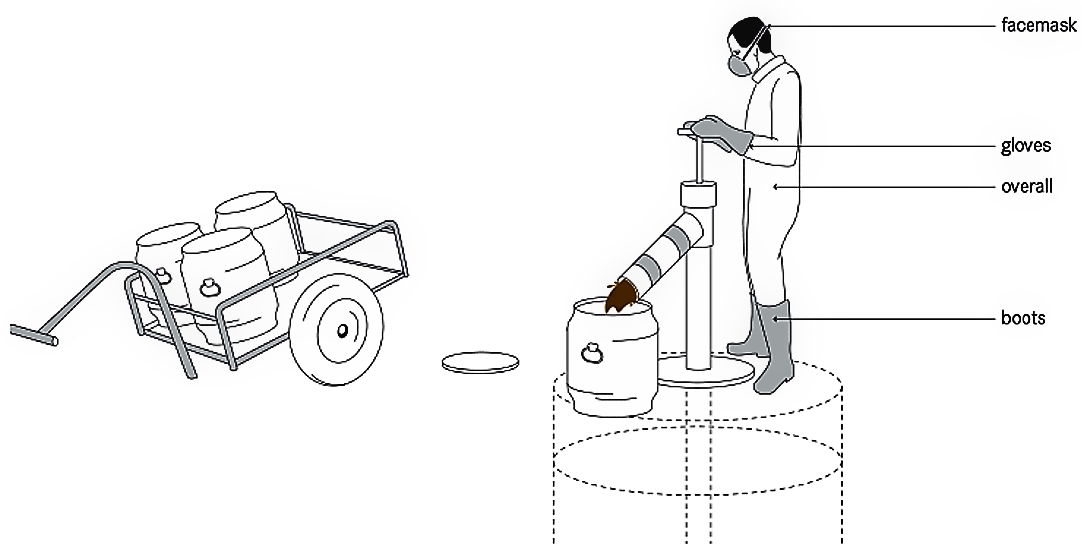
Human-powered emptying of pits, vaults and tanks can be done in one of two ways:
- using buckets and shovels, or
- using a portable, manually operated pump specially designed for sludge (e.g., the Gulper, the Rammer, the MDHP or the MAPET).
Some sanitation technologies can only be emptied manually, for example, the fossa alternaor dehydration vaults. These technologies must be emptied with a shovel because the material is solid and cannot be removed with a vacuum or a pump (e.g. the fossa alterna, aroborloo, composting toilets or UDDTs).
When sludge is viscous or watery it should be emptied with a hand pump, a MAPET or a vacuum truck, and not with buckets because of the high risk of collapsing pits, toxic fumes, and exposure to unsanitised sludge.
Manual sludge pumps are relatively new inventions and have shown promise as being low-cost, effective solutions for sludge emptying where, because of access, safety or economics, other emptying techniques are not possible.
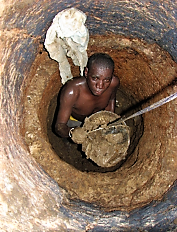
Manual sludge pumps like the Pooh Pump or the Gulper are relatively new inventions and have shown promise as being low-cost, effective solutions for sludge emptying where, because of access, safety or economics, other sludge emptying techniques are not possible. Sludge hand pumps work on the same concept as water hand pumps: the bottom of the pipe is lowered into the pit/tank while the operator remains at the surface. As the operator pushes and pulls the handle, the sludge is pumped up and is then discharged through the discharge spout. The sludge can be collected in barrels, bags or carts, and removed from the site with little danger to the operator. Hand pumps can be locally made with steel rods and valves in a PVC casing.
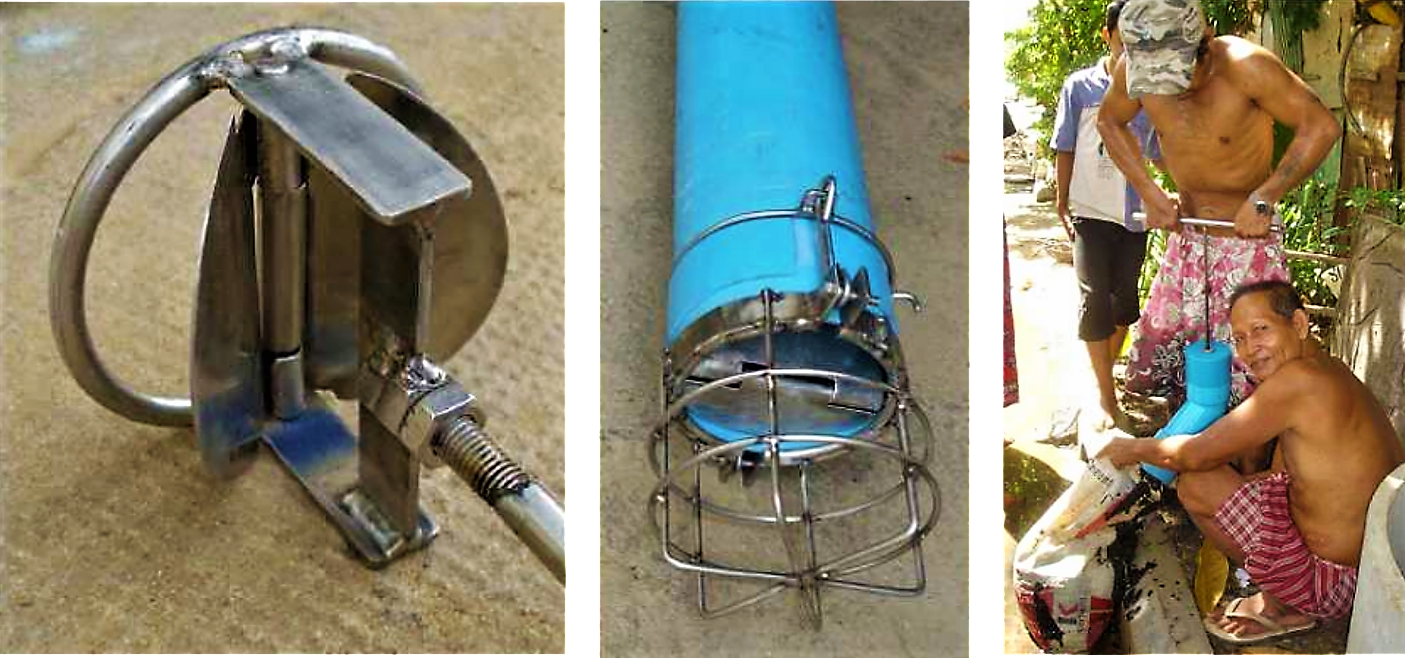
A MAPET (MAnual Pit Emptying Technology) consists of a manually operated pump connected to a vacuum tank mounted on a pushcart. A hose is connected to the tank and is used to suck sludge from the pit. When the hand pump is turned, air is sucked out of the vacuum tank and sludge is sucked up into the tank. Depending on the consistency of the sludge, the MAPET can pump up to a height of 3 m.
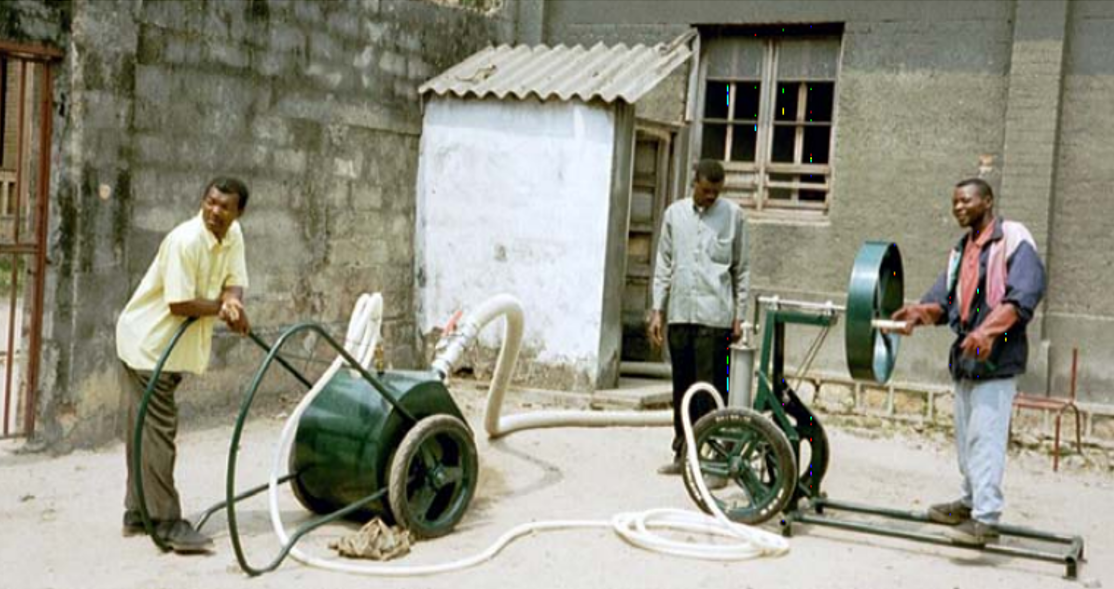
A team of MAPET emptiers consists of three men. The emptying job starts with contacting the customer, negotiating over the price, picking up the MAPET equipment from its parking place and taking it to the customer's house.This preparation entails mixing the sludge with water (to make it more fluid) and (possibly) paraffin (to reduce the smell; MUELLER & RIJNSBURGER 1992).After the hose-pipes have been connected the sludge pumping can start. Depending on the sludge's viscosity and the pumping head, it can take five to twenty minutes to fill up one 200 litre tank with sludge. When a tank is full, the hose-pipes are disconnected and the tank is manoeuvred next to the dug hole, and topped over in discharge position. A pressure relieve valve is opened and the sludge flows to where it is supposed to be discharged. After putting the tank back in its original position, pumping can start anew and the vacuum tank is filled again. This routine is repeated until the required amount of sludge has been taken out. The equipment is then cleaned and returned to its parking place (MUELLER & RIJNSBURGER 1992). Care should be taken to find a solution where the sludge can be disposed of safely and sustainably.
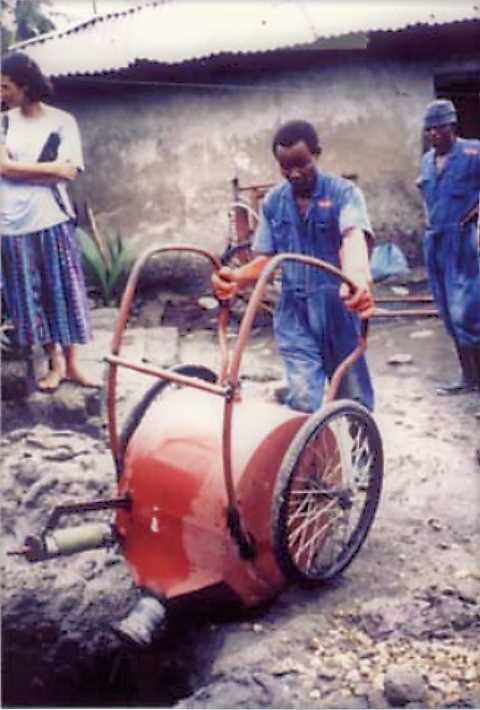
Depending on cultural factors and political support, workers dealing with manual emptying may be viewed as providing an important service to the community. Government-run programmes should strive to legitimize the work of the labourer and provide an enabling environment by providing permits and licences, as well as helping to legalize the practice of emptying latrines manually.
Yet it has to be kept in mind that handling fresh excreta poses the operators and general public to unhealthy and unsightly conditions (DFID 1998). The most important aspect of manual emptying is ensuring that workers are adequately protected with gloves, boots, overalls and facemasks. Regular medical exams and vaccinations should be required for everyone working with sludge. After the work, all tools and also the workers hands must be cleaned with water and soap.

It is a common practice to add chemicals or oil during the pit emptying process to avoid odours. This is not recommended, however, because it causes difficulties in the subsequent treatment units, as well as additional health threats to the workers.
If manual access to the contents of a pit requires demolishing the slab, it may be more cost-effective to use a manual sludge pump to empty the latrine. However, hand pumps cannot empty the entire pit and, therefore, emptying may be required more frequently (once a year).
Manually operated sludge pumps require daily maintenance (cleaning, repairing and disinfection). Workers who manually empty latrines should clean and maintain their protective clothing and tools to prevent contact with the sludge.
| Working Principle | Some sanitation technologies can only be emptied manually, either with a manually operated pump in the case of sludges (e.g. from septic tanks or pit latrines) or a shovel or bucket in the case of solids (e.g. composting toilets, UDDTs or fossa alternas).Typical manual pumps are gulpers or MAPETs. |
| Capacity/Adequacy | Hand-pumps (e.g. gulper) and MAPETs are appropriate for areas that are not served by vacuum trucks, where vacuum- truck emptying is too costly, or where narrow streets and poor roads may limit the ability of a vacuum truck to access the site. Although the distance to a suitable sludge discharge point is a limiting factor. |
| Performance | Manually operated pumps are a significant improvement over the bucket method. It protects the worker’s health and is very fast. |
| Costs | Poo pump and Gulper: Low-cost |
| Self-help Compatibility | Can be built and repaired with locally available material. |
| O&M | Manually operated pumps must be cleaned after every use and the metallic parts should be oiled. |
| Reliability | If well maintained and constructed it is usable for many years. |
| Main strength | These technologies can access small streets and provides service to unsewered areas. |
| Main weakness | People have to pay the emptiers. MAPET generates high capital and O&M costs. |
Hand pumps can be used for liquid and, to a certain degree, viscous sludge. Domestic refuse in the pit makes emptying much more difficult. The pumping of sludge, which contains coarse solid wastes or grease, can lead to clogging of the device, and chemical additives can corrode pipes, pumps and tanks. The hand pump is a significant improvement over the bucket method and could prove to be a sustainable business opportunity in some regions.
Manually operated sludge pumps are appropriate for areas that are not served or not accessible by vacuum trucks, or where vacuum truck emptying i too costly. They are well suited to dense, urban and informal settlements, although the type and size of transport vehicle determines the feasible distance to the discharge point. Large vehicles may not be able to manoeuvre within narrow streets and alleys, while smaller vehicles may not be able to travel long distances. These technologies are more feasible when there is a transfer station nearby.
The bucket or shovel method is only appropriate for the emptying of solid products with relatively low health risk (e.g. compost or dried faeces from composting toilets and UDDTS).
Guidance Manual on Water Supply and Sanitation Programmes
This manual has been prepared as a tool to help improve DFID's (Department for International Developments, United Kingdom) support for water supply and sanitation projects and programmes in developing countries. Its particular focus is on how DFID assistance can best meet the needs of the urban and rural poor for water supply and sanitation services.
DFID (1998): Guidance Manual on Water Supply and Sanitation Programmes. London: Water, Engineering and Development Centre (WEDC) for the Department for International Development (DFID) URL [Accessed: 09.05.2018]Bringing pit emptying out of the darkness
This paper is one of a series that look sanitation partnerships in poor urban communities, that questions when and why partnership may be appropriate or inappropriate to the delivery of on-site sanitation services. It is a comparison of two manual emptying projects.
EALES, K. (2005): Bringing pit emptying out of the darkness. A comparison of approaches in Durban, South Africa, and Kibera, Kenya. United Kingdom: Building Partnerships for Development in Water and Sanitation URL [Accessed: 21.10.2013]Faecal Sludge Management. Lecture Notes
This module pays special attention to the haulage, treatment and reuse or disposal of faecal sludge. It covers both technical and non-technical (socio-cultural, economic, political etc.) aspects and provides practical information on design, financing and planning of faecal sludge treatment plants.
EAWAG/SANDEC (2008): Faecal Sludge Management. Lecture Notes. (= Sandec Training Tool 1.0, Module 5 ). Duebendorf: Swiss Federal Institute of Aquatic Science (EAWAG), Department of Water and Sanitation in Developing Countries (SANDEC) URL [Accessed: 23.05.2012]The Gulper – a manual latrine/drain pit pump
This short document describes the functioning of the gulper technology to empty pit latrines or septic tanks.
IaW (2007): The Gulper – a manual latrine/drain pit pump. Phnom Penh/Casteren: Ideas at Work (IaW) URL [Accessed: 28.05.2019]MAPET. A neighbourhood based pit emptying service with locally manufactured hand pump equipment in Dar es Salaam, Tanzania
This document is the final report of the MAPET project in Dar es Salaam, Tanzania. Project objectives were to contribute to the improvement of environmental sanitation in unplanned areas by facilitating an effective and hygienic pit emptying services, and to improve the informal traditional pit emptying method by making it more efficient and hygienic.
MULLER, M.S. RIJNSBURGER J. (1992): MAPET. A neighbourhood based pit emptying service with locally manufactured hand pump equipment in Dar es Salaam, Tanzania. Gouda: WASTE advisers on urban environment and development URL [Accessed: 28.05.2019]Manual Desludging Hand Pump (MDHP)
This paper introduces manual desludging hand pump. The design, its use and maintenance is illustrated with many images.
OXFAM (n.y): Manual Desludging Hand Pump (MDHP). Various places: Oxfam International URL [Accessed: 09.12.2010]Compendium of Sanitation Systems and Technologies. 2nd Revised Edition
This compendium gives a systematic overview on different sanitation systems and technologies and describes a wide range of available low-cost sanitation technologies.
TILLEY, E. ULRICH, L. LUETHI, C. REYMOND, P. ZURBRUEGG, C. (2014): Compendium of Sanitation Systems and Technologies. 2nd Revised Edition. Duebendorf, Switzerland: Swiss Federal Institute of Aquatic Science and Technology (Eawag) URL [Accessed: 28.07.2014] PDFCompendium of Sanitation Systems and Technologies (Arabic)
This is the Arabic version of the Compendium of Sanitation Systems and Technologies. The Compendium gives a systematic overview on different sanitation systems and technologies and describes a wide range of available low-cost sanitation technologies.
TILLEY, E. ULRICH, L. LUETHI, C. REYMOND, P. SCHERTENLEIB, R. ZURBRUEGG, C. (2014): Compendium of Sanitation Systems and Technologies (Arabic). 2nd Revised Edition. Duebendorf, Switzerland: Swiss Federal Institute of Aquatic Science and Technology (Eawag) PDFAdventures in search of the ideal portable pit-emptying machine
This article explores the ideal portable pit-emptying machine for South Africa owing to site access constraints. The Water Research Commission of South Africa funded experimental development of a number of technologies designed to fill the gap between large vacuum tankers and manual emptying. This paper describes these attempts.
STILL, D. O RIORDAN, M. MC BRIDE, A. LOUTON, B. (2013): Adventures in search of the ideal portable pit-emptying machine. Rugby: Practical Action Publishing URL [Accessed: 07.08.2013]Faecal Sludge Management. Lecture Notes
This module pays special attention to the haulage, treatment and reuse or disposal of faecal sludge. It covers both technical and non-technical (socio-cultural, economic, political etc.) aspects and provides practical information on design, financing and planning of faecal sludge treatment plants.
EAWAG/SANDEC (2008): Faecal Sludge Management. Lecture Notes. (= Sandec Training Tool 1.0, Module 5 ). Duebendorf: Swiss Federal Institute of Aquatic Science (EAWAG), Department of Water and Sanitation in Developing Countries (SANDEC) URL [Accessed: 23.05.2012]MAPET. A neighbourhood based pit emptying service with locally manufactured hand pump equipment in Dar es Salaam, Tanzania
This document is the final report of the MAPET project in Dar es Salaam, Tanzania. Project objectives were to contribute to the improvement of environmental sanitation in unplanned areas by facilitating an effective and hygienic pit emptying services, and to improve the informal traditional pit emptying method by making it more efficient and hygienic.
MULLER, M.S. RIJNSBURGER J. (1992): MAPET. A neighbourhood based pit emptying service with locally manufactured hand pump equipment in Dar es Salaam, Tanzania. Gouda: WASTE advisers on urban environment and development URL [Accessed: 28.05.2019]MAPET. A neighbourhood based pit emptying service with locally manufactured hand pump equipment in Dar es Salaam, Tanzania
This document is the final report of the MAPET project in Dar es Salaam, Tanzania. Project objectives were to contribute to the improvement of environmental sanitation in unplanned areas by facilitating an effective and hygienic pit emptying services, and to improve the informal traditional pit emptying method by making it more efficient and hygienic.
MULLER, M.S. RIJNSBURGER J. (1992): MAPET. A neighbourhood based pit emptying service with locally manufactured hand pump equipment in Dar es Salaam, Tanzania. Gouda: WASTE advisers on urban environment and development URL [Accessed: 28.05.2019]Manual Desludging Hand Pump (MDHP)
This paper introduces manual desludging hand pump. The design, its use and maintenance is illustrated with many images.
OXFAM (n.y): Manual Desludging Hand Pump (MDHP). Various places: Oxfam International URL [Accessed: 09.12.2010]Microbial Exposure and Health Assessments in Sanitation Technologies and Systems
This book focuses on the health factors related to pathogenic organisms. The attempt is to assess and review evidences in relation to health impact and to discuss the findings based on epidemiological evidence, risk assessment and behavioural aspects and practices.
STENSTROEM, A. SEIDU, R. EKANE, M. ZURBRUEGG, C. (2011): Microbial Exposure and Health Assessments in Sanitation Technologies and Systems. (= EcoSanRes Series , 1 ). Stockholm: Stockholm Environment Institute (SEI) URL [Accessed: 28.11.2011]Compendium of Sanitation Systems and Technologies
This compendium gives a systematic overview on different sanitation systems and technologies and describes a wide range of available low-cost sanitation technologies.
TILLEY, E. LUETHI, C. MOREL, A. ZURBRUEGG, C. SCHERTENLEIB, R. (2008): Compendium of Sanitation Systems and Technologies. Duebendorf, Switzerland: Swiss Federal Institute of Aquatic Science and Technology (EAWAG) and Water Supply and Sanitation Collaborative Council (WSSCC) URL [Accessed: 15.02.2010] PDFEmptying Pit Latrines
This technical brief describes several possibilities of emptying pit latrines and helps to find the most suitable method.
PICKFORD, J. SHAW, R. (1997): Emptying Pit Latrines. (= Technical Briefs, No. 54 ). Loughborough: Water and Environmental health at London and Loughborough (WELL) URL [Accessed: 28.05.2019]Bringing pit emptying out of the darkness
This paper is one of a series that look sanitation partnerships in poor urban communities, that questions when and why partnership may be appropriate or inappropriate to the delivery of on-site sanitation services. It is a comparison of two manual emptying projects.
EALES, K. (2005): Bringing pit emptying out of the darkness. A comparison of approaches in Durban, South Africa, and Kibera, Kenya. United Kingdom: Building Partnerships for Development in Water and Sanitation URL [Accessed: 21.10.2013]The Gulper – a manual latrine/drain pit pump
This short document describes the functioning of the gulper technology to empty pit latrines or septic tanks.
IaW (2007): The Gulper – a manual latrine/drain pit pump. Phnom Penh/Casteren: Ideas at Work (IaW) URL [Accessed: 28.05.2019]Manual Desludging Hand Pump (MDHP)
This paper introduces manual desludging hand pump. The design, its use and maintenance is illustrated with many images.
OXFAM (n.y): Manual Desludging Hand Pump (MDHP). Various places: Oxfam International URL [Accessed: 09.12.2010]After the Pit Latrine is Full. What Then? Effective Options for Pit Latrine Management
In rural areas, the Ventilated Improved Pit Latrine (VIP) is often considered as the basic standard for sanitation. Large numbers of VIPs have even been constructed in urban areas where other sanitation options were not economically feasible. Pit filling times vary widely depending on factors such as numbers of users, soil type and pit lining methodology. Pits are also generally used for solid waste disposal, and this hastens the filling time.
STILL, D.A. (2002): After the Pit Latrine is Full. What Then? Effective Options for Pit Latrine Management. Pretoria: Water Research Commission URL [Accessed: 09.12.2010]Environmental Health. Presentation
This PowerPoint presentation contains information on environmental health aspects of water and sanitation. It contains a definition of environmental health, describes various water-related diseases and also hygiene approaches. There is also a related lecture to this document.
EAWAG ; SANDEC (2008): Environmental Health. Presentation. (= Sandec Training Tool 1.0, Module 2 ). Duebendorf: Swiss Federal Institute of Aquatic Science (EAWAG), Department of Water and Sanitation in Developing Countries (SANDEC) URL [Accessed: 23.05.2012]Faecal Sludge Management. Pdf Presentation
A presentation about faecal sludge management in developing countries.
EAWAG ; SANDEC (2008): Faecal Sludge Management. Pdf Presentation. (= Sandec Training Tool 1.0, Module 5 ). Duebendorf: Swiss Federal Institute of Aquatic Science (Eawag), Department of Water and Sanitation in Developing Countries (Sandec) URL [Accessed: 23.05.2012]Pit Emptying Business in Temeke-Dsm. Tanzania Country Programme
A chapter of this presentation shows experiences with the latrine emptying technology ‘gulper’.
WATERAID (2010): Pit Emptying Business in Temeke-Dsm. Tanzania Country Programme. London: WaterAid URL [Accessed: 13.12.2010]http://desludging.org/
This website contains all important information about the manual desludging hand pump.
http://www.flickr.com/gtzecosan
Pictures about the reality of manual pit emptying in Kenya.

